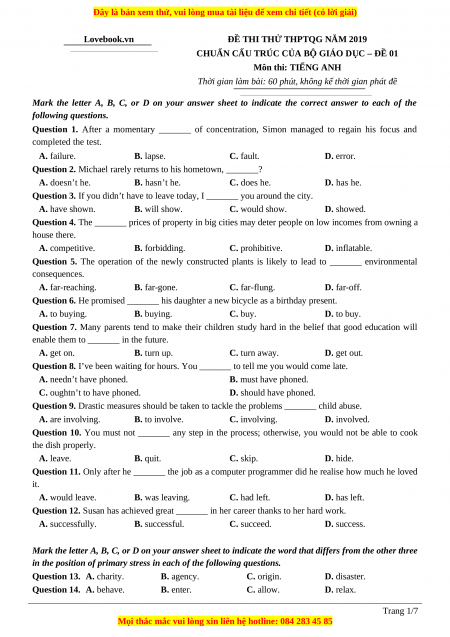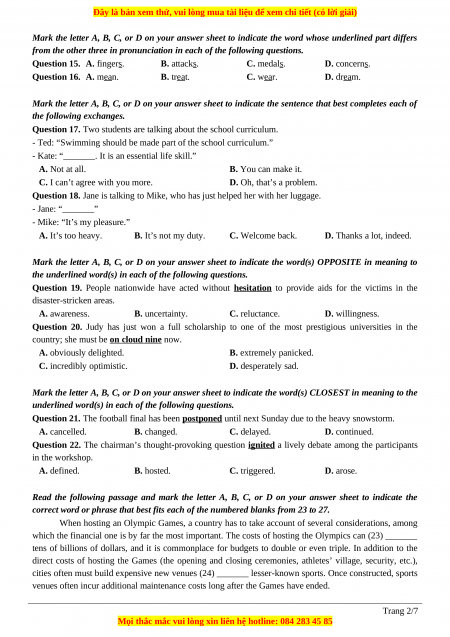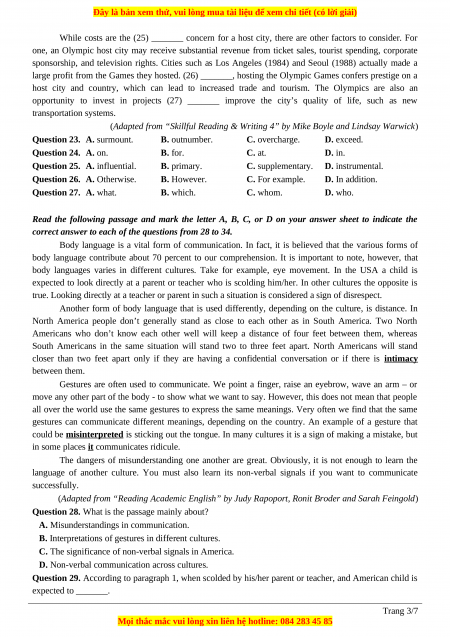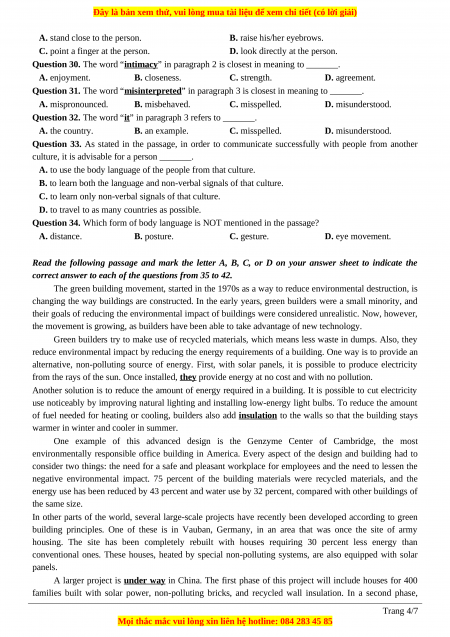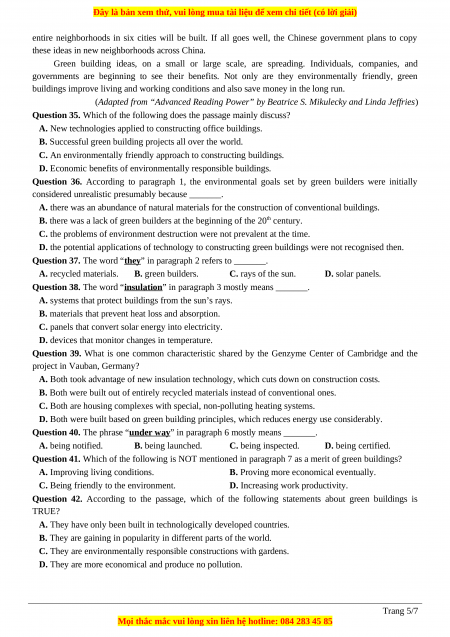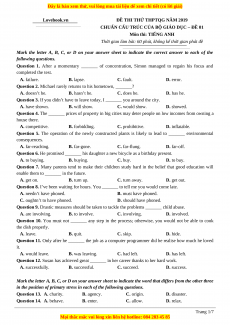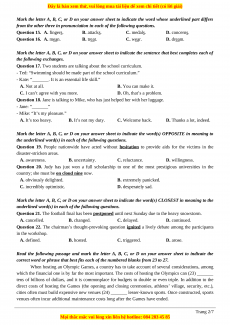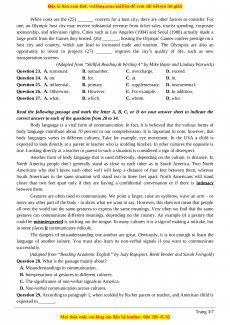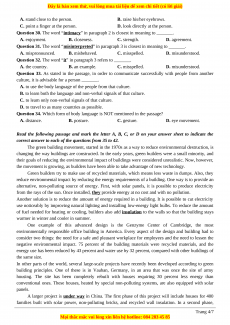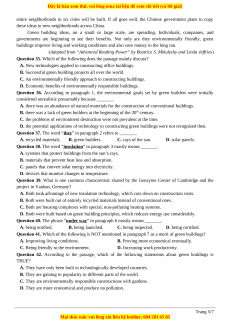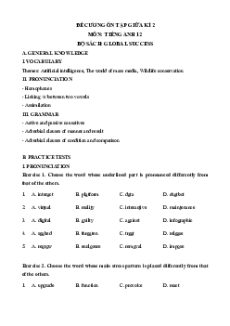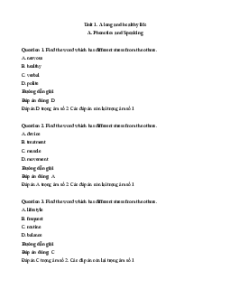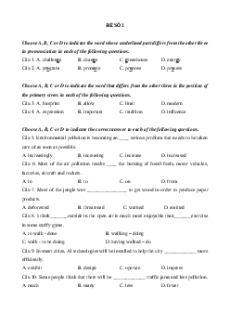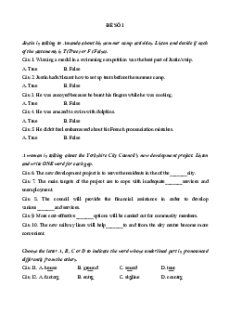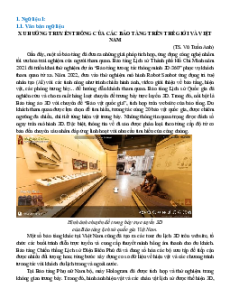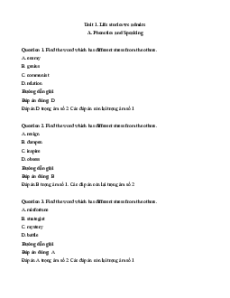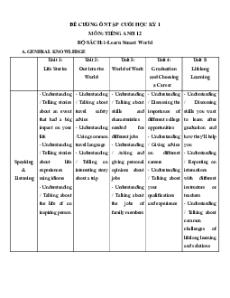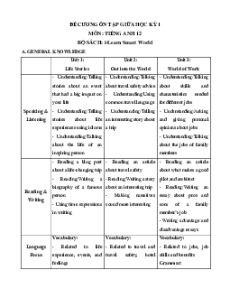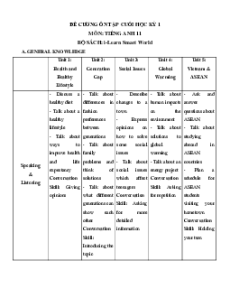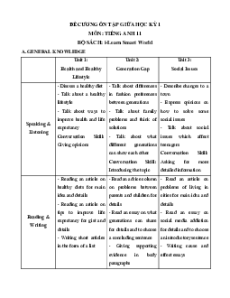Lovebook.vn
ĐỀ THI THỬ THPTQG NĂM 2019
CHUẨN CẤU TRÚC CỦA BỘ GIÁO DỤC – ĐỀ 01 Môn thi: TIẾNG ANH
Thời gian làm bài: 60 phút, không kể thời gian phát đề
Mark the letter A, B, C, or D on your answer sheet to indicate the correct answer to each of the following questions.
Question 1. After a momentary _______ of concentration, Simon managed to regain his focus and completed the test. A. failure. B. lapse. C. fault. D. error.
Question 2. Michael rarely returns to his hometown, _______? A. doesn’t he. B. hasn’t he. C. does he. D. has he.
Question 3. If you didn’t have to leave today, I _______ you around the city. A. have shown. B. will show. C. would show. D. showed.
Question 4. The _______ prices of property in big cities may deter people on low incomes from owning a house there. A. competitive. B. forbidding. C. prohibitive. D. inflatable.
Question 5. The operation of the newly constructed plants is likely to lead to _______ environmental consequences. A. far-reaching. B. far-gone. C. far-flung. D. far-off.
Question 6. He promised _______ his daughter a new bicycle as a birthday present. A. to buying. B. buying. C. buy. D. to buy.
Question 7. Many parents tend to make their children study hard in the belief that good education will
enable them to _______ in the future. A. get on. B. turn up. C. turn away. D. get out.
Question 8. I’ve been waiting for hours. You _______ to tell me you would come late.
A. needn’t have phoned. B. must have phoned.
C. oughtn’t to have phoned. D. should have phoned.
Question 9. Drastic measures should be taken to tackle the problems _______ child abuse. A. are involving. B. to involve. C. involving. D. involved.
Question 10. You must not _______ any step in the process; otherwise, you would not be able to cook the dish properly. A. leave. B. quit. C. skip. D. hide.
Question 11. Only after he _______ the job as a computer programmer did he realise how much he loved it. A. would leave. B. was leaving. C. had left. D. has left.
Question 12. Susan has achieved great _______ in her career thanks to her hard work. A. successfully. B. successful. C. succeed. D. success.
Mark the letter A, B, C, or D on your answer sheet to indicate the word that differs from the other three
in the position of primary stress in each of the following questions.
Question 13. A. charity. B. agency. C. origin. D. disaster. Question 14. A. behave. B. enter. C. allow. D. relax. Trang 1/7
Mark the letter A, B, C, or D on your answer sheet to indicate the word whose underlined part differs
from the other three in pronunciation in each of the following questions.
Question 15. A. fingers. B. attacks. C. medals. D. concerns. Question 16. A. mean. B. treat. C. wear. D. dream.
Mark the letter A, B, C, or D on your answer sheet to indicate the sentence that best completes each of the following exchanges.
Question 17. Two students are talking about the school curriculum.
- Ted: “Swimming should be made part of the school curriculum.”
- Kate: “_______. It is an essential life skill.” A. Not at all. B. You can make it.
C. I can’t agree with you more.
D. Oh, that’s a problem.
Question 18. Jane is talking to Mike, who has just helped her with her luggage. - Jane: “_______”
- Mike: “It’s my pleasure.” A. It’s too heavy. B. It’s not my duty. C. Welcome back.
D. Thanks a lot, indeed.
Mark the letter A, B, C, or D on your answer sheet to indicate the word(s) OPPOSITE in meaning to
the underlined word(s) in each of the following questions.
Question 19. People nationwide have acted without hesitation to provide aids for the victims in the disaster-stricken areas. A. awareness. B. uncertainty. C. reluctance. D. willingness.
Question 20. Judy has just won a full scholarship to one of the most prestigious universities in the
country; she must be on cloud nine now. A. obviously delighted. B. extremely panicked.
C. incredibly optimistic. D. desperately sad.
Mark the letter A, B, C, or D on your answer sheet to indicate the word(s) CLOSEST in meaning to the
underlined word(s) in each of the following questions.
Question 21. The football final has been postponed until next Sunday due to the heavy snowstorm. A. cancelled. B. changed. C. delayed. D. continued.
Question 22. The chairman’s thought-provoking question ignited a lively debate among the participants in the workshop. A. defined. B. hosted. C. triggered. D. arose.
Read the following passage and mark the letter A, B, C, or D on your answer sheet to indicate the
correct word or phrase that best fits each of the numbered blanks from 23 to 27.
When hosting an Olympic Games, a country has to take account of several considerations, among
which the financial one is by far the most important. The costs of hosting the Olympics can (23) _______
tens of billions of dollars, and it is commonplace for budgets to double or even triple. In addition to the
direct costs of hosting the Games (the opening and closing ceremonies, athletes’ village, security, etc.),
cities often must build expensive new venues (24) _______ lesser-known sports. Once constructed, sports
venues often incur additional maintenance costs long after the Games have ended. Trang 2/7
While costs are the (25) _______ concern for a host city, there are other factors to consider. For
one, an Olympic host city may receive substantial revenue from ticket sales, tourist spending, corporate
sponsorship, and television rights. Cities such as Los Angeles (1984) and Seoul (1988) actually made a
large profit from the Games they hosted. (26) _______, hosting the Olympic Games confers prestige on a
host city and country, which can lead to increased trade and tourism. The Olympics are also an
opportunity to invest in projects (27) _______ improve the city’s quality of life, such as new transportation systems.
(Adapted from “Skillful Reading & Writing 4” by Mike Boyle and Lindsay Warwick)
Question 23. A. surmount. B. outnumber. C. overcharge. D. exceed. Question 24. A. on. B. for. C. at. D. in.
Question 25. A. influential. B. primary. C. supplementary. D. instrumental.
Question 26. A. Otherwise. B. However. C. For example. D. In addition. Question 27. A. what. B. which. C. whom. D. who.
Read the following passage and mark the letter A, B, C, or D on your answer sheet to indicate the
correct answer to each of the questions from 28 to 34.
Body language is a vital form of communication. In fact, it is believed that the various forms of
body language contribute about 70 percent to our comprehension. It is important to note, however, that
body languages varies in different cultures. Take for example, eye movement. In the USA a child is
expected to look directly at a parent or teacher who is scolding him/her. In other cultures the opposite is
true. Looking directly at a teacher or parent in such a situation is considered a sign of disrespect.
Another form of body language that is used differently, depending on the culture, is distance. In
North America people don’t generally stand as close to each other as in South America. Two North
Americans who don’t know each other well will keep a distance of four feet between them, whereas
South Americans in the same situation will stand two to three feet apart. North Americans will stand
closer than two feet apart only if they are having a confidential conversation or if there is intimacy between them.
Gestures are often used to communicate. We point a finger, raise an eyebrow, wave an arm – or
move any other part of the body - to show what we want to say. However, this does not mean that people
all over the world use the same gestures to express the same meanings. Very often we find that the same
gestures can communicate different meanings, depending on the country. An example of a gesture that
could be misinterpreted is sticking out the tongue. In many cultures it is a sign of making a mistake, but
in some places it communicates ridicule.
The dangers of misunderstanding one another are great. Obviously, it is not enough to learn the
language of another culture. You must also learn its non-verbal signals if you want to communicate successfully.
(Adapted from “Reading Academic English” by Judy Rapoport, Ronit Broder and Sarah Feingold)
Question 28. What is the passage mainly about?
A. Misunderstandings in communication.
B. Interpretations of gestures in different cultures.
C. The significance of non-verbal signals in America.
D. Non-verbal communication across cultures.
Question 29. According to paragraph 1, when scolded by his/her parent or teacher, and American child is expected to _______. Trang 3/7
A. stand close to the person.
B. raise his/her eyebrows.
C. point a finger at the person.
D. look directly at the person.
Question 30. The word “intimacy” in paragraph 2 is closest in meaning to _______. A. enjoyment. B. closeness. C. strength. D. agreement.
Question 31. The word “misinterpreted” in paragraph 3 is closest in meaning to _______. A. mispronounced. B. misbehaved. C. misspelled. D. misunderstood.
Question 32. The word “it” in paragraph 3 refers to _______. A. the country. B. an example. C. misspelled. D. misunderstood.
Question 33. As stated in the passage, in order to communicate successfully with people from another
culture, it is advisable for a person _______.
A. to use the body language of the people from that culture.
B. to learn both the language and non-verbal signals of that culture.
C. to learn only non-verbal signals of that culture.
D. to travel to as many countries as possible.
Question 34. Which form of body language is NOT mentioned in the passage? A. distance. B. posture. C. gesture. D. eye movement.
Read the following passage and mark the letter A, B, C, or D on your answer sheet to indicate the
correct answer to each of the questions from 35 to 42.
The green building movement, started in the 1970s as a way to reduce environmental destruction, is
changing the way buildings are constructed. In the early years, green builders were a small minority, and
their goals of reducing the environmental impact of buildings were considered unrealistic. Now, however,
the movement is growing, as builders have been able to take advantage of new technology.
Green builders try to make use of recycled materials, which means less waste in dumps. Also, they
reduce environmental impact by reducing the energy requirements of a building. One way is to provide an
alternative, non-polluting source of energy. First, with solar panels, it is possible to produce electricity
from the rays of the sun. Once installed, they provide energy at no cost and with no pollution.
Another solution is to reduce the amount of energy required in a building. It is possible to cut electricity
use noticeably by improving natural lighting and installing low-energy light bulbs. To reduce the amount
of fuel needed for heating or cooling, builders also add insulation to the walls so that the building stays
warmer in winter and cooler in summer.
One example of this advanced design is the Genzyme Center of Cambridge, the most
environmentally responsible office building in America. Every aspect of the design and building had to
consider two things: the need for a safe and pleasant workplace for employees and the need to lessen the
negative environmental impact. 75 percent of the building materials were recycled materials, and the
energy use has been reduced by 43 percent and water use by 32 percent, compared with other buildings of the same size.
In other parts of the world, several large-scale projects have recently been developed according to green
building principles. One of these is in Vauban, Germany, in an area that was once the site of army
housing. The site has been completely rebuilt with houses requiring 30 percent less energy than
conventional ones. These houses, heated by special non-polluting systems, are also equipped with solar panels.
A larger project is under way in China. The first phase of this project will include houses for 400
families built with solar power, non-polluting bricks, and recycled wall insulation. In a second phase, Trang 4/7
Bộ 34 đề thi thử THPT Quốc gia Tiếng Anh năm 2023 - sách Lovebook
872
436 lượt tải
MUA NGAY ĐỂ XEM TOÀN BỘ TÀI LIỆU
CÁCH MUA:
- B1: Gửi phí vào TK:
1133836868- CT TNHH DAU TU VA DV GD VIETJACK - Ngân hàng MB (QR) - B2: Nhắn tin tới Zalo VietJack Official ( nhấn vào đây ) để xác nhận thanh toán và tải tài liệu - giáo án
Liên hệ ngay Hotline hỗ trợ: 084 283 45 85
Đề thi được cập nhật liên tục trong gói này từ nay đến hết tháng 6/2023. Chúng tôi đảm bảo đủ số lượng đề đã cam kết hoặc có thể nhiều hơn, tất cả có BẢN WORD, LỜI GIẢI CHI TIẾT và tải về dễ dàng.
Để tải tài liệu gốc về máy bạn click vào nút Tải Xuống ở trên!
Thuộc bộ (mua theo bộ để tiết kiệm hơn):
- Bộ 34 đề thi TN THPT Quốc gia môn Tiếng anh có lời giải chi tiết được biên soạn theo chuẩn cấu trúc minh họa của Bộ Giáo dục và Đào tạo năm 2022-2023.
- File word có lời giải chi tiết 100%.
- Mua trọn bộ sẽ tiết kiệm hơn tải lẻ 50%.
Đánh giá
4.6 / 5(872 )5
4
3
2
1
Trọng Bình
Tài liệu hay
Giúp ích cho tôi rất nhiều
Duy Trần
Tài liệu chuẩn
Rất thích tài liệu bên VJ soạn (bám sát chương trình dạy)
TÀI LIỆU BỘ BÁN CHẠY MÔN Tiếng Anh
Xem thêmTÀI LIỆU BỘ BÁN CHẠY Lớp 12
Xem thêmTài liệu bộ mới nhất

Đây là bản xem thử, vui lòng mua tài liệu để xem chi tiết (có lời giải)
Lovebook.vn ĐỀ THI THỬ THPTQG NĂM 2019
CHUẨN CẤU TRÚC CỦA BỘ GIÁO DỤC – ĐỀ 01
Môn thi: TIẾNG ANH
Thời gian làm bài: 60 phút, không kể thời gian phát đề
Mark the letter A, B, C, or D on your answer sheet to indicate the correct answer to each of the
following questions.
Question 1. After a momentary _______ of concentration, Simon managed to regain his focus and
completed the test.
A. failure. B. lapse. C. fault. D. error.
Question 2. Michael rarely returns to his hometown, _______?
A. doesn’t he. B. hasn’t he. C. does he. D. has he.
Question 3. If you didn’t have to leave today, I _______ you around the city.
A. have shown. B. will show. C. would show. D. showed.
Question 4. The _______ prices of property in big cities may deter people on low incomes from owning a
house there.
A. competitive. B. forbidding. C. prohibitive. D. inflatable.
Question 5. The operation of the newly constructed plants is likely to lead to _______ environmental
consequences.
A. far-reaching. B. far-gone. C. far-flung. D. far-off.
Question 6. He promised _______ his daughter a new bicycle as a birthday present.
A. to buying. B. buying. C. buy. D. to buy.
Question 7. Many parents tend to make their children study hard in the belief that good education will
enable them to _______ in the future.
A. get on. B. turn up. C. turn away. D. get out.
Question 8. I’ve been waiting for hours. You _______ to tell me you would come late.
A. needn’t have phoned. B. must have phoned.
C. oughtn’t to have phoned. D. should have phoned.
Question 9. Drastic measures should be taken to tackle the problems _______ child abuse.
A. are involving. B. to involve. C. involving. D. involved.
Question 10. You must not _______ any step in the process; otherwise, you would not be able to cook
the dish properly.
A. leave. B. quit. C. skip. D. hide.
Question 11. Only after he _______ the job as a computer programmer did he realise how much he loved
it.
A. would leave. B. was leaving. C. had left. D. has left.
Question 12. Susan has achieved great _______ in her career thanks to her hard work.
A. successfully. B. successful. C. succeed. D. success.
Mark the letter A, B, C, or D on your answer sheet to indicate the word that differs from the other three
in the position of primary stress in each of the following questions.
Question 13. A. charity. B. agency. C. origin. D. disaster.
Question 14. A. behave. B. enter. C. allow. D. relax.
Trang 1/7
Mọi thắc mắc vui lòng xin liên hệ hotline: 084 283 45 85

Đây là bản xem thử, vui lòng mua tài liệu để xem chi tiết (có lời giải)
Mark the letter A, B, C, or D on your answer sheet to indicate the word whose underlined part differs
from the other three in pronunciation in each of the following questions.
Question 15. A. fingers. B. attacks. C. medals. D. concerns.
Question 16. A. mean. B. treat. C. wear. D. dream.
Mark the letter A, B, C, or D on your answer sheet to indicate the sentence that best completes each of
the following exchanges.
Question 17. Two students are talking about the school curriculum.
- Ted: “Swimming should be made part of the school curriculum.”
- Kate: “_______. It is an essential life skill.”
A. Not at all. B. You can make it.
C. I can’t agree with you more. D. Oh, that’s a problem.
Question 18. Jane is talking to Mike, who has just helped her with her luggage.
- Jane: “_______”
- Mike: “It’s my pleasure.”
A. It’s too heavy. B. It’s not my duty. C. Welcome back. D. Thanks a lot, indeed.
Mark the letter A, B, C, or D on your answer sheet to indicate the word(s) OPPOSITE in meaning to
the underlined word(s) in each of the following questions.
Question 19. People nationwide have acted without hesitation to provide aids for the victims in the
disaster-stricken areas.
A. awareness. B. uncertainty. C. reluctance. D. willingness.
Question 20. Judy has just won a full scholarship to one of the most prestigious universities in the
country; she must be on cloud nine now.
A. obviously delighted. B. extremely panicked.
C. incredibly optimistic. D. desperately sad.
Mark the letter A, B, C, or D on your answer sheet to indicate the word(s) CLOSEST in meaning to the
underlined word(s) in each of the following questions.
Question 21. The football final has been postponed until next Sunday due to the heavy snowstorm.
A. cancelled. B. changed. C. delayed. D. continued.
Question 22. The chairman’s thought-provoking question ignited a lively debate among the participants
in the workshop.
A. defined. B. hosted. C. triggered. D. arose.
Read the following passage and mark the letter A, B, C, or D on your answer sheet to indicate the
correct word or phrase that best fits each of the numbered blanks from 23 to 27.
When hosting an Olympic Games, a country has to take account of several considerations, among
which the financial one is by far the most important. The costs of hosting the Olympics can (23) _______
tens of billions of dollars, and it is commonplace for budgets to double or even triple. In addition to the
direct costs of hosting the Games (the opening and closing ceremonies, athletes’ village, security, etc.),
cities often must build expensive new venues (24) _______ lesser-known sports. Once constructed, sports
venues often incur additional maintenance costs long after the Games have ended.
Trang 2/7
Mọi thắc mắc vui lòng xin liên hệ hotline: 084 283 45 85

Đây là bản xem thử, vui lòng mua tài liệu để xem chi tiết (có lời giải)
While costs are the (25) _______ concern for a host city, there are other factors to consider. For
one, an Olympic host city may receive substantial revenue from ticket sales, tourist spending, corporate
sponsorship, and television rights. Cities such as Los Angeles (1984) and Seoul (1988) actually made a
large profit from the Games they hosted. (26) _______, hosting the Olympic Games confers prestige on a
host city and country, which can lead to increased trade and tourism. The Olympics are also an
opportunity to invest in projects (27) _______ improve the city’s quality of life, such as new
transportation systems.
(Adapted from “Skillful Reading & Writing 4” by Mike Boyle and Lindsay Warwick)
Question 23. A. surmount. B. outnumber. C. overcharge. D. exceed.
Question 24. A. on. B. for. C. at. D. in.
Question 25. A. influential. B. primary. C. supplementary. D. instrumental.
Question 26. A. Otherwise. B. However. C. For example. D. In addition.
Question 27. A. what. B. which. C. whom. D. who.
Read the following passage and mark the letter A, B, C, or D on your answer sheet to indicate the
correct answer to each of the questions from 28 to 34.
Body language is a vital form of communication. In fact, it is believed that the various forms of
body language contribute about 70 percent to our comprehension. It is important to note, however, that
body languages varies in different cultures. Take for example, eye movement. In the USA a child is
expected to look directly at a parent or teacher who is scolding him/her. In other cultures the opposite is
true. Looking directly at a teacher or parent in such a situation is considered a sign of disrespect.
Another form of body language that is used differently, depending on the culture, is distance. In
North America people don’t generally stand as close to each other as in South America. Two North
Americans who don’t know each other well will keep a distance of four feet between them, whereas
South Americans in the same situation will stand two to three feet apart. North Americans will stand
closer than two feet apart only if they are having a confidential conversation or if there is intimacy
between them.
Gestures are often used to communicate. We point a finger, raise an eyebrow, wave an arm – or
move any other part of the body - to show what we want to say. However, this does not mean that people
all over the world use the same gestures to express the same meanings. Very often we find that the same
gestures can communicate different meanings, depending on the country. An example of a gesture that
could be misinterpreted is sticking out the tongue. In many cultures it is a sign of making a mistake, but
in some places it communicates ridicule.
The dangers of misunderstanding one another are great. Obviously, it is not enough to learn the
language of another culture. You must also learn its non-verbal signals if you want to communicate
successfully.
(Adapted from “Reading Academic English” by Judy Rapoport, Ronit Broder and Sarah Feingold)
Question 28. What is the passage mainly about?
A. Misunderstandings in communication.
B. Interpretations of gestures in different cultures.
C. The significance of non-verbal signals in America.
D. Non-verbal communication across cultures.
Question 29. According to paragraph 1, when scolded by his/her parent or teacher, and American child is
expected to _______.
Trang 3/7
Mọi thắc mắc vui lòng xin liên hệ hotline: 084 283 45 85

Đây là bản xem thử, vui lòng mua tài liệu để xem chi tiết (có lời giải)
A. stand close to the person. B. raise his/her eyebrows.
C. point a finger at the person. D. look directly at the person.
Question 30. The word “intimacy” in paragraph 2 is closest in meaning to _______.
A. enjoyment. B. closeness. C. strength. D. agreement.
Question 31. The word “misinterpreted” in paragraph 3 is closest in meaning to _______.
A. mispronounced. B. misbehaved. C. misspelled. D. misunderstood.
Question 32. The word “it” in paragraph 3 refers to _______.
A. the country. B. an example. C. misspelled. D. misunderstood.
Question 33. As stated in the passage, in order to communicate successfully with people from another
culture, it is advisable for a person _______.
A. to use the body language of the people from that culture.
B. to learn both the language and non-verbal signals of that culture.
C. to learn only non-verbal signals of that culture.
D. to travel to as many countries as possible.
Question 34. Which form of body language is NOT mentioned in the passage?
A. distance. B. posture. C. gesture. D. eye movement.
Read the following passage and mark the letter A, B, C, or D on your answer sheet to indicate the
correct answer to each of the questions from 35 to 42.
The green building movement, started in the 1970s as a way to reduce environmental destruction, is
changing the way buildings are constructed. In the early years, green builders were a small minority, and
their goals of reducing the environmental impact of buildings were considered unrealistic. Now, however,
the movement is growing, as builders have been able to take advantage of new technology.
Green builders try to make use of recycled materials, which means less waste in dumps. Also, they
reduce environmental impact by reducing the energy requirements of a building. One way is to provide an
alternative, non-polluting source of energy. First, with solar panels, it is possible to produce electricity
from the rays of the sun. Once installed, they provide energy at no cost and with no pollution.
Another solution is to reduce the amount of energy required in a building. It is possible to cut electricity
use noticeably by improving natural lighting and installing low-energy light bulbs. To reduce the amount
of fuel needed for heating or cooling, builders also add insulation to the walls so that the building stays
warmer in winter and cooler in summer.
One example of this advanced design is the Genzyme Center of Cambridge, the most
environmentally responsible office building in America. Every aspect of the design and building had to
consider two things: the need for a safe and pleasant workplace for employees and the need to lessen the
negative environmental impact. 75 percent of the building materials were recycled materials, and the
energy use has been reduced by 43 percent and water use by 32 percent, compared with other buildings of
the same size.
In other parts of the world, several large-scale projects have recently been developed according to green
building principles. One of these is in Vauban, Germany, in an area that was once the site of army
housing. The site has been completely rebuilt with houses requiring 30 percent less energy than
conventional ones. These houses, heated by special non-polluting systems, are also equipped with solar
panels.
A larger project is under way in China. The first phase of this project will include houses for 400
families built with solar power, non-polluting bricks, and recycled wall insulation. In a second phase,
Trang 4/7
Mọi thắc mắc vui lòng xin liên hệ hotline: 084 283 45 85

Đây là bản xem thử, vui lòng mua tài liệu để xem chi tiết (có lời giải)
entire neighborhoods in six cities will be built. If all goes well, the Chinese government plans to copy
these ideas in new neighborhoods across China.
Green building ideas, on a small or large scale, are spreading. Individuals, companies, and
governments are beginning to see their benefits. Not only are they environmentally friendly, green
buildings improve living and working conditions and also save money in the long run.
(Adapted from “Advanced Reading Power” by Beatrice S. Mikulecky and Linda Jeffries)
Question 35. Which of the following does the passage mainly discuss?
A. New technologies applied to constructing office buildings.
B. Successful green building projects all over the world.
C. An environmentally friendly approach to constructing buildings.
D. Economic benefits of environmentally responsible buildings.
Question 36. According to paragraph 1, the environmental goals set by green builders were initially
considered unrealistic presumably because _______.
A. there was an abundance of natural materials for the construction of conventional buildings.
B. there was a lack of green builders at the beginning of the 20
th
century.
C. the problems of environment destruction were not prevalent at the time.
D. the potential applications of technology to constructing green buildings were not recognised then.
Question 37. The word “they” in paragraph 2 refers to _______.
A. recycled materials. B. green builders. C. rays of the sun. D. solar panels.
Question 38. The word “insulation” in paragraph 3 mostly means _______.
A. systems that protect buildings from the sun’s rays.
B. materials that prevent heat loss and absorption.
C. panels that convert solar energy into electricity.
D. devices that monitor changes in temperature.
Question 39. What is one common characteristic shared by the Genzyme Center of Cambridge and the
project in Vauban, Germany?
A. Both took advantage of new insulation technology, which cuts down on construction costs.
B. Both were built out of entirely recycled materials instead of conventional ones.
C. Both are housing complexes with special, non-polluting heating systems.
D. Both were built based on green building principles, which reduces energy use considerably.
Question 40. The phrase “under way” in paragraph 6 mostly means _______.
A. being notified. B. being launched. C. being inspected. D. being certified.
Question 41. Which of the following is NOT mentioned in paragraph 7 as a merit of green buildings?
A. Improving living conditions. B. Proving more economical eventually.
C. Being friendly to the environment. D. Increasing work productivity.
Question 42. According to the passage, which of the following statements about green buildings is
TRUE?
A. They have only been built in technologically developed countries.
B. They are gaining in popularity in different parts of the world.
C. They are environmentally responsible constructions with gardens.
D. They are more economical and produce no pollution.
Trang 5/7
Mọi thắc mắc vui lòng xin liên hệ hotline: 084 283 45 85
